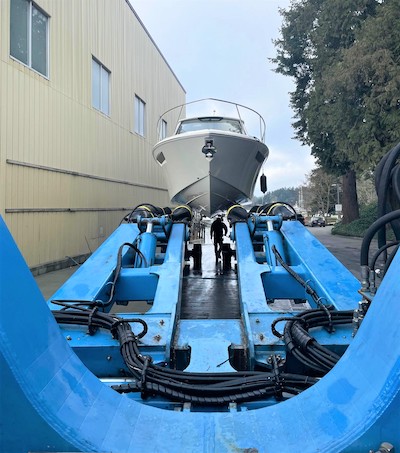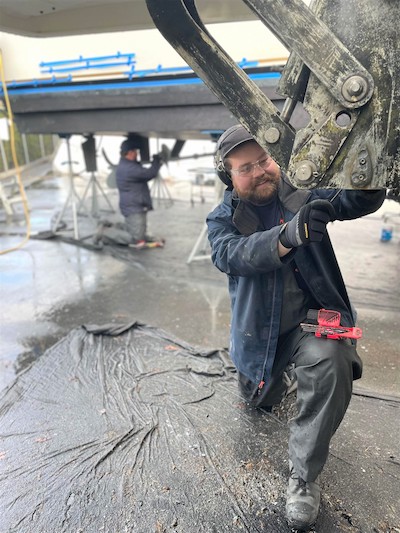Boat and Hull Maintenance
Complete Haul-Out Service at Van Isle Marina Yacht Park
Boat maintenance is a key part of keeping your boat seaworthy, safe and looking great. After all, there is nothing more enjoyable than cruising in a boat you know is in top notch condition and is well protected from the corrosive elements of the ocean.
Saltwater, marine organisms and UV rays can all take their toll on your boat’s finish, integrity and performance, but regular maintenance can help retain the appearance and extend the life of your vessel.
While yacht care can be daunting, time-consuming and expensive, you don’t have to do it all yourself! Instead, make the most of the services and equipment available at Van Isle Marina’s World Class Yacht Park to keep annual maintenance chores manageable and effective.
Why Do I Need To Do Annual Maintenance on My Yacht?
Performance and fuel consumption can be adversely impacted when any part of the boat’s operating system – from its engine to its electrical systems or even its paint work – is not maintained.
Poor boat maintenance might mean a yacht that doesn’t run as fast, or an engine that vibrates, but there can also be serious malfunctions or expensive replacements which no one wants.
Some care tasks are required after every trip, and some only need to be addressed annually. Annual boat maintenance tasks include:
- Mechanical check-ups
- Electrical system care
- Topside painting
- Fabric maintenance
- Waxing
For the purposes of this article we are focusing on the maintenance of the hull of the vessel which includes:
- Antifouling painting and epoxy barrier coat prep
- Zinc replacement
- Running gear maintenance
Hull maintenance should be done as part of your annual haul-out when other care tasks can be completed too. It is most important these tasks are completed while your boat is out of the water so damage can be properly assessed and corrected before the next sailing season.
See Van Isle Marina’s ‘Boat Maintenance Checklist’ for a complete list of the boat maintenance requirements you should be addressing every year.
What is Hull Maintenance and Why is it Important?
Hull maintenance, or bottom side maintenance, is the maintenance of everything underneath the water line, from the running gear to the hull itself.
Since this part of your vessel spends most of its life underwater, it is susceptible to wear and deterioration due to salt and marine organisms like barnacles. Annual boat maintenance will clean away any grime, dirt and sea life, revitalize the running gear and provide protection for the coming year.
Hull and bottom side maintenance tasks include:
- Antifouling bottom painting and epoxy barrier coat prepping
If your boat is in the water most of the time, antifouling bottom paint will need to be applied annually. These paints include biocides such as copper which discourage barnacles and other aquatic organisms from attaching themselves to your hull.
Different types of paint are available. Look at your owners’ guide or talk to an expert at Van Isle Marina to determine which paint is best for your vessel:
Ablative, also known as self-polishing, paint gradually wears away to reveal fresh biocide as water moves against your boat. Great for yachts which are taken out on the ocean regularly, but not recommended for boats that sit idle in the water for long periods.
Hard, or non-sloughing, paint creates a tough hard coating which releases biocide gradually. Ideal for fast boats as it won’t wear as quickly as ablative paint, but it will require removal before fresh paint can be applied.
Hybrid paint can hold up to fast speeds and repeated haul-outs while remaining smooth.
Epoxy barrier coat is a two-part paint that can be applied before bottom paint to fill any uneven spots and create better paint adhesion.
- Changing zinc anodes

Zinc anodes, also known as sacrificial anodes, are installed on boats to protect the metal components of the boat itself from galvanic corrosion. This is an electrochemical process that happens when two different metals which are contacted electronically, are submerged in water. Without zinc anodes (which corrode faster than other metals) propellers, shafts, rudders, drives and even the hull can be significantly damaged. Zinc anodes are placed in various locations on your boat and should be replaced at least annually.
- Cleaning and polishing running gear
Maintenance of running gear such as hull fittings, shafts, propellers, rudders, struts and intake grates is vital to protect the longevity of your yacht. When your boat is hauled out these should be cleaned, inspected and polished to prevent sluggish performance and engine vibrations.
Can I Get Help With My Hull Maintenance?
Maintenance?
Although some of these maintenance tasks can be done by boat owners with some time and patience, there are a number of advantages to asking an expert to complete maintenance tasks.
- They have the experience to get a smooth finish on bottom paint – a rough paint finish can result in drag that impacts speed.
- The Yacht Park has the correct equipment and trained staff so tasks are done right the first time.
- You can save time compared to doing it yourself.
The Yacht Park at Van Isle Marina has a great team of experts available to help with haul-outs and bottom-side maintenance tasks. If you wish to complete some maintenance work yourself, the Yacht Park offers rental scaffolding and our dedicated staff can assist you with getting the products and equipment you require.
Van Isle Marina’s World Class Yacht Park Offers Premium Maintenance Services
At Van Isle Marina, our Yacht Park features a self-propelled haul-out trailer which enables our staff to take care of everything without you even needing to be on site.
Yachts can be lifted and blocked, ready for the boat owner to complete scheduled maintenance work, or it can go directly onto the water treatment ramp where our staff can pressure wash, scrape and sand before other maintenance begins.
Van Isle Marina’s Yacht Park crew would be pleased to assist you with your bottom-side services. For any other maintenance or repair tasks, our Yacht Park staff can offer a list of approved trades who are welcome to work on your vessel on site.
For more information about the Yacht Park, dry storage and maintenance services we offer, contact us today.